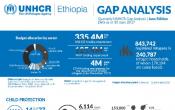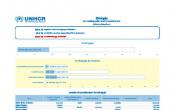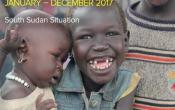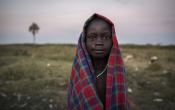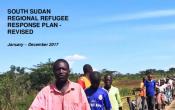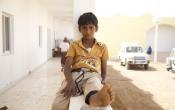Ethiopia
Operation: Ethiopia
Location
{"longitude":40,"latitude":9,"zoom_level":0}
Latest update of camps and office locations 21 Nov 2016. By clicking on the icons on the map, additional information is displayed.
Key Figures
| 2018 planning figures | |
| 189,000 | women will receive sanitary materials |
| 149,500 | children will be enrolled in primary education |
| 28,500 | households will benefit from constructed sanitary facilities |
| 4,500 | transitional shelters will be provided to people of concern |
| 11.2 | Prevalence of global acute malnutrition (6-59 months) |
| 2016 end-year results | |
| 62% | of primary school-aged children were enrolled in primary education |
| 12,950 | best interest assessments were conducted |
| 2,000 | refugee resettlement cases (7,037 individual were submitted to relevant countries |
| 18.1 | litres of water were made available per refugee per day; 11 out of 25 camps met the standard of 20 litres/person/day |
| 0.2/1,000 | the monthly under 5 mortality rate; meeting the international standard of <1.5/1,000/month |
Latest Updates and Related Links
People of Concern
7%
Increase in
2016
2016
| 2016 | 794,133 |
| 2015 | 739,156 |
| 2014 | 665,240 |

[["Refugees",791631],["Asylum-seekers",1964],["Returned refugees",1],["Others of concern",537]]
Loading ...
Ethiopia
< Back
2016
{"categories":[2013,2014,2015,2016,2017,2018],"budget":[193.15087926,283.71879953,311.641954085,279.32741856,330.54803881,320.512224923],"expenditure":[105.80377323,175.31367849,152.1095677,135.61655247,null,null]}
{"categories":[2013,2014,2015,2016,2017,2018],"p1":[192.99460025,283.71879953,311.641954085,279.32741856,330.54803881,318.542362923],"p2":[0.15627901,null,null,null,null,null],"p3":[null,null,null,null,null,null],"p4":[null,null,null,null,null,1.969862]}
{"categories":[2013,2014,2015,2016,2017,2018],"p1":[105.7491314,175.31367849,152.1095677,135.61655247,null,null],"p2":[0.05464183,null,null,null,null,null],"p3":[null,null,null,null,null,null],"p4":[null,null,null,null,null,null]}
Loading ...
CHOOSE A YEAR
- 2014
- 2015
- 2016
- 2017
- 2018
Year-end Overview
Plan Overview
Working environment
The Government of Ethiopia maintains its strong commitment to the 1951 Convention Relating to the Status of Refugees and a favourable protection environment, which is characterized by many years of implementing an open-door policy towards refugees. With 27 refugee camps and a large number of refugees living in urban or settlement areas, Ethiopia is the second largest refugee operation in Africa with over 855,000 refugees from Eritrea, Somalia, South Sudan, Sudan and Yemen, amongst others.
The commitments the Government of Ethiopia made at the Leader’s Summit in September 2016 present an unprecedented and unique opportunity for UNHCR and its partners to implement hitherto unchartered initiatives, such as the expansion of the policies on alternatives to camps and refugees in urban areas, local integration and access to work permits for refugees.
UNHCR's main Government counterpart and implementing partner to ensure protection of refugees in Ethiopia is the Administration for Refugee and Returnee Affairs (ARRA). ARRA has increased, and will further pursue, collaborative initiatives with other agencies, ministries and donors to ensure the complementary resources being received by the government, such as the Development Response to Displacement Impacts Project (DRDIP) and the World Bank’s International Development Associations 2018 sub-window, which will be effectively coordinated to improve the wellbeing of refugees as well as host communities. In addition, UNHCR works with some 40 partners, and is fully engaged in the Humanitarian Country Team. The Office will continue building on the well-established coordination fora such as the Refugee Task Force, and donor, NGO and inter-agency meetings at the field and in the camps.
In line with UNHCR Ethiopia’s multi-year and multi-partner planning strategy, the operation builds on current initiatives to rationalize existing partnerships and pursues new and more sustainable ones. On-going demarches with non-traditional partners in development such as the World Bank, are redoubled. Opportunities presented by the government of Ethiopia’s pledges, opportunities drawing from Ethiopia as one of the Comprehensive Refugee Response Framework (CRRF) roll-out countries and the related positive response from donors and development actors allow for the prioritization of interventions and allocation of resources within the framework of protection programming in 2018 and beyond.
Key priorities
UNHCR has developed comprehensive protection and solutions strategies for urban refugees and refugees from Eritrea, Somalia, South Sudan and Sudan. The strategic objectives are adapted to suit the specific situations and needs of each population group. Common priorities for 2018 are:
- Preserving and enhancing the protection environment and living conditions for refugees and promotion of peaceful coexistence;
- Strengthening refugee protection through the expansion of improved community-based and multi-sectorial child protection and SGBV programmes;
- Strengthening access to basic services;
- Expanding livelihoods opportunities;
- Supporting the implementation of the Government’s commitments to expand long-term access to rights, services, and self-reliance opportunities, in line with the CRRF;
- Contributing to building stronger linkages to local and national development related interventions;
- Expanding access to solutions and legal pathways to protection and solutions, where feasible.

